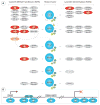Balancing histone methylation activities in psychiatric disorders
- PMID: 21429800
- PMCID: PMC3134618
- DOI: 10.1016/j.molmed.2011.02.003
Balancing histone methylation activities in psychiatric disorders
Abstract
Alterations in histone lysine methylation and other epigenetic regulators of gene expression contribute to changes in brain transcriptomes in mood and psychosis spectrum disorders, including depression and schizophrenia. Genetic association studies and animal models implicate multiple lysine methyltransferases and demethylases in the neurobiology of emotion and cognition. Here, we review the role of histone lysine methylation and transcriptional regulation in normal and diseased neurodevelopment and discuss various methyltransferases and demethylases as potential therapeutic targets in the treatment of neuropsychiatric disease.
Copyright © 2011 Elsevier Ltd. All rights reserved.
Figures

References
-
- Lewis DA, Gonzalez-Burgos G. Pathophysiologically based treatment interventions in schizophrenia. Nat Med. 2006;12(9):1016–22. - PubMed
-
- Kim S, Webster MJ. Correlation analysis between genome-wide expression profiles and cytoarchitectural abnormalities in the prefrontal cortex of psychiatric disorders. Mol Psychiatry. 2010;15(3):326–36. - PubMed
Publication types
MeSH terms
Substances
Grants and funding
LinkOut - more resources
Full Text Sources
Other Literature Sources
Medical

